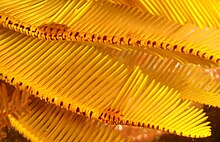Myzostomida
This article needs additional citations for verification. (December 2013) |
| Myzostomida | |
|---|---|

| |
| Myzostoma fuscomaculatum on its host the crinoid Tropiometra carinata | |
| Scientific classification | |
| Kingdom: | |
| Phylum: | |
| Class: | |
| Order: | Myzostomida
|
The Myzostomida are an order of small marine polychaete worms, which are parasitic on crinoids. These unusual Lophotrochozoa were first discovered by Friedrich Sigismund Leuckart in 1827.
Morphology


A typical myzostomid has a flattened, rounded shape, with a thin edge drawn out into delicate radiating hairs called cirri. The dorsal surface is smooth, with five pairs of parapodia on the bottom surface. These parapodia are armed with supporting and hooked setae, by means of which the worm adheres to its host. Beyond the parapodia are four pairs of organs, often called suckers. These organs are probably of sensory nature, and are comparable to the lateral sense organs of capitellids. The mouth and cloacal opening are generally at opposite ends of the bottom surface. The former leads to a protrusible pharynx, from which the esophagus opens into a wide intestinal chamber with branching lateral diverticula. There appears to be no vascular system. The nervous system consists of a circumoesophageal nerve, with scarcely differentiated brain, joining below a large ganglionic mass, no doubt representing many fused ganglia. The dorsoventral and the parapodial muscles are much developed, while the coelom is reduced mostly to branched spaces in which the genital products ripen.
Full-grown myzostomids are hermaphrodites. Their internal organs consist of a branched sac opening to the exterior or each side. The paired ovaries discharge their eggs into a median chamber with side branches, often called the uterus, from which the ripe ova (eggs) are discharged by a mediar dorsal pore into the end of the rectum.
Biology
Some species, such as Myzostoma cirriferum, move about on the host; others, such as Myzostoma glabrum, remain stationary with the pharynx inserted in the mouth of the crinoid. Myzostoma deformator gives rise to a gall on the arm of the host, one joint of the pinnule growing round the worm so as to enclose it in a cyst while Myzostoma pulvinar lives in the alimentary canal of a species of Antedon.
Fridtjof Nansen wrote in 1885 the thesis Bidrag til myzostomernes anatomi og histologi[1] on the Myzostomida.
Families and genera
According to the World register of Marine Species, these families and genera are accepted in this group:[2]
- Endomyzostomatidae[3]
- Myzostomida incertae sedis[4]
- Myzostomidae Benham, 1896[5]
- Cystimyzostomum Jagersten, 1940
- Endomyzostoma Perrier, 1897
- Hypomyzostoma
- Myzostoma Leuckart, 1829
- Notopharyngoides
- Protomyszostomum
References
This article incorporates text from a publication now in the public domain: Chisholm, Hugh, ed. (1911). Encyclopædia Britannica (11th ed.). Cambridge University Press. {{cite encyclopedia}}: Missing or empty |title= (help)
- ^ [1] Bidrag til myzostomernes anatomi og histologi
- ^ http://marinespecies.org/aphia.php?p=taxdetails&id=233983 accessed 13 September 2013
- ^ http://marinespecies.org/aphia.php?p=taxdetails&id=249687 accessed 13 September 2013
- ^ http://marinespecies.org/aphia.php?p=taxdetails&id=254452 accessed 13 September 2013
- ^ http://marinespecies.org/aphia.php?p=taxdetails&id=22609 accessed 13 September 2013
Further reading
- Bleidorn C. et al. 2009. On the phylogenetic position of Myzostomida: can 77 genes get it wrong? BMC Evolutionary Biology 2009, 9:150. doi:10.1186/1471-2148-9-150
